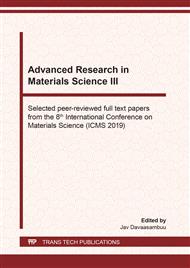[1]
B.M. Smirnov, Generation of cluster beams, Phys. Usp. 46 (2003) 589-628.
Google Scholar
[2]
H. Pauly, Cluster Beams, Fast and Slow Beams, Accessory Equipment, and Applications vol 2, Springer-Verlag, Berlin, (2000).
Google Scholar
[3]
A. Perez, P. Melinon, V. Dupuis, P. Jensen, B. Prevel, J. Tuaillon, L. Bardotti, C. Martet, M. Treilleux and M. Broye, Cluster assembled materials: a novel class of nanostructured solids with original structures and properties, Appl. Phys. 30 (1997) 709-721.
DOI: 10.1088/0022-3727/30/5/003
Google Scholar
[4]
G.N. Makarov, Extreme processes in clusters impacting on a solid surface, Phys. Usp. 49 (2006) 117-166.
Google Scholar
[5]
S. Panigrahi, S. Kundu, S.K. Ghosh, S. Nath and T. Pal, General method of synthesis for metal nanoparticles, J. Nanopart. Res. 6 (2004) 411-414.
DOI: 10.1007/s11051-004-6575-2
Google Scholar
[6]
H-S.P. Wong, S. Raoux and S.B. Kim, Phase Change Memory, Proc. IEEE. 98 (2010) 2201-2227.
Google Scholar
[7]
Yu.Ya. Gafner, S.L. Gafner, L.V. Redel and Zh.V. Goloven'ko, The estimation of possibility of using «order-disorder» transition phenomena in Ni, Cu and Au nanoclusters for advancing the efficiency of information recording processes, J. Nanosci. Nanotechnol. 14 (2014) 5138-5144.
DOI: 10.1166/jnn.2014.8688
Google Scholar
[8]
F. Cleri and V. Rosato, Tight-binding potentials for transition metals and alloys, Phys. Rev. 48 (1993) 22-33.
DOI: 10.1103/physrevb.48.22
Google Scholar
[9]
S.L. Gafner, L.V. Redel' and Yu.Ya. Gafner, On the problem of the formation of structural modifications in Ni nanoclusters, Phys. Met. Metallogr. 104 (2007) 180-186.
DOI: 10.1134/s0031918x0708011x
Google Scholar
[10]
S.L. Gafner, L.V. Redel' and Yu.Ya. Gafner, Simulation of the processes of structuring of copper nanoclusters in terms of the tight-binding potential, J. Exp. Theor. Phys. 108 (2009) 784-799.
DOI: 10.1134/s1063776109050070
Google Scholar
[11]
G. Mazzone, V. Rosato, M. Pintore, F. Delogu, P.F. Demontis and G. Suffritti, Molecular-dynamics calculations of thermodynamic properties of metastable alloys, Phys. Rev. 55 (1997) 837-842.
DOI: 10.1103/physrevb.55.837
Google Scholar
[12]
S. Nose, A unified formulation of the constant temperature molecular dynamics methods, 1984 J. Phys. Chem. 81 (1984) 511-519.
Google Scholar
[13]
T. Pang, An introduction to computational physics, University Press, Cambridge, (2006).
Google Scholar
[14]
H.C. Andersеn, Molecular dynamics simulations at constant pressure and/or temperature, J. Phys. Chem. 72 (1980) 2384-2393.
Google Scholar


